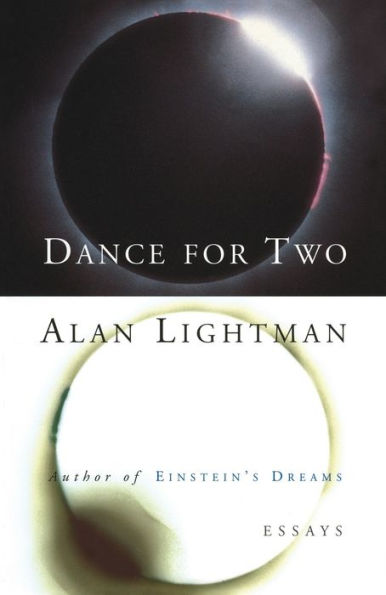

Paperback(1ST)
-
PICK UP IN STORECheck Availability at Nearby Stores
Available within 2 business hours
Related collections and offers
Overview
Here are pieces that touch on both the ethereal and the corporeal; the dependence of a ballerina on the laws of physics, the choice of every scientist makes between tinkering and theorizing, the unscientific nature of discovery, the impulse behind an unprompted smile. Dance for Two is an intimate and fascinating look into the creative compulsions shared by the artist and the scientist.

Product Details
| ISBN-13: | 9780679758778 |
|---|---|
| Publisher: | Knopf Doubleday Publishing Group |
| Publication date: | 03/26/1996 |
| Edition description: | 1ST |
| Pages: | 192 |
| Product dimensions: | 5.20(w) x 7.99(h) x 0.41(d) |
About the Author
Read an Excerpt
Pas de Deux
In the soft blue light, the ballerina glides across the stage and takes to the air, her toes touching Earth imperceptibly. Sauté, batterie, sauté. Legs cross and flutter, arms unfold into an open arch. The ballerina knows that the easiest way to ruin a good performance is to think too much about what her body is doing. Better to trust in the years of daily exercises, the muscles’ own understanding of force and balance.
While she dances, Nature is playing its own part, flawlessly and with absolute reliability. On pointe, the ballerina’s own weight is precisely balanced by the push of floor against shoe, the molecules in contact squeezed just the right amount to counter force with equal force. Gravity balanced with electricity,
An invisible line runs from the center of the Earth through the ballerina’s point of contact and upward. If her own center should drift a centimeter from this line, gravitational torques will topple her. She knows nothing of mechanics, but she can hover on her toes for minutes at a time, and her body is continuously making the tiny corrections that reveal an intimacy with torque and inertia.
Gravity has the elegant property of acceleration everything equally. As a result, astronauts become weightless, orbiting Earth on exactly the same trajectories as their spaceships and thus seeming to float within. Einstein understood this better than anyone and described gravity with a theory more geometry than physics, more curves than forces. The ballerina, leaping upward lightly, hands weightless for a moment amid flowers she has dropped midair, all falling on the same trajectory.
Not she prepares for a pirouette, right leg moving back to fourth position, pushing off one foot, arms coming in to speed the turn. Before losing balance she gets four rotations. Make dancers, on demi-pointe and with greater contact area, can sometimes go six or eight. The ballerina recovers well, giving her spin smoothly back to Earth and remembering to land in fifth position smiling. Briefly her feet come to rest, caught between the passage of spin and the friction of the floor. Friction is important. Every body persists in its state of rest or of uniform motion unless acted upon by outside forces. Every action requires a reaction.
The ballerina depends on the constancy of the laws of physics, even though she herself is slightly unpredictable. In this same performance last night she went only three and a half turns through her first pirouette, and then took the arabesque several feet from where she takes it now. Regardless of these discrepancies, the atoms in the floor, wherever she happens to touch and at one millisecond’s notice, must be prepared to respond with faithful accuracy. Newton’s laws, Coulomb’s force, and the charge of electrons must be identical night after night—otherwise, the ballerina will misjudge the resiliency of the floor or the needed moment of inertia. Her art is more beautiful in its uncertainty. Nature’s art comes in its certainty.
The ballerina assumes one pose after another, each fragile and symmetrical. In the physics of solids, crystal structures can be found that appear identical after rotations by one-half, one-third, one-quarter, and one-sixth of a circle. Crystals with one-fifth and one-seventh symmetries do not exist because space cannot be filled with touch pentagons or septagons. The ballerina reflects a series of natural forms. She is first ethereal, then lyrical. She has struggled for years to develop a personal style, embellished with fragments from the great dancers. As she dances, Nature, in the mirror, pursues its own style effortlessly. It is the ultimate in classic technique, unaltered since the universe began.
For an ending, the ballerina does a demi-plié and jumps two feet into the air. The Earth, balancing her momentum, responds with its own sauté and changes orbit by one ten-trillionth of an atom’s width. No one notices, but it is exactly right.
Table of Contents
Foreword ixPas de Deux 3
A Flash of Light 6
Smile 12
Is the Earth Round or Flat? 17
If Birds Can Fly, Why, Oh Why, Can't I? 22
Students and Teachers 29
Time Travel and Papa Joe's Pipe 39
In His Image 45
Mirage 54
To Cleave an Atom 58
Elapsed Expectations 68
A Visit by Mr. Newton 73
Origins 79
A Day in December 84
Progress 87
I=V/R 94
Nothing but the Truth 100
Time for the Stars 107
A Modern-Day Yankee in a Connecticut Court 117
The Origin of the Universe 133
How the Camel Got His Hump 142
Ironland 145
Other Rooms 151
Seasons 159
